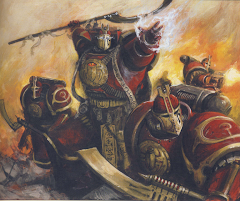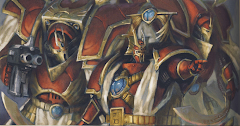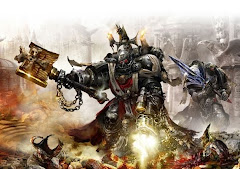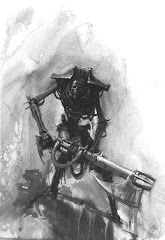I often sit down with Army Builder to figure out the next 40K list I want to mess with. I think "I would really like to use my Chaos Marines for a change," but then I remember that anything they can do, lots of other armies can do better. Is that really the case though? Let's look at Codex: Chaos Space Marines and see what’s truly unique about them.
Special Characters
HQ Monstrous Creatures
3rd HQ choice - Summoned Greater Daemon
Strong Psychic Powers: Lash of Submission, Wind of Chaos and Warp Time
Cost-effective customizable-role Terminators
Cost-effective variety of versatile Marine squads
Unlimited scoring units
Deep Strike + Assault
Obliterators
I tried to pick the things that gave them the greatest in-game advantages, so try not to get all butt-hurt because I didn’t include ‘Nurgle Bikers.’ While they’re cool and may be decent enough against certain armies, they just aren’t cost-effective for the amount of damage they deal (which is minimal). Heck, they’re not even fearless!
Abaddon, Kharne and Typhus all pack quite a punch, and even Ahriman can be devastating if used correctly. These are the hallmarks of the codex. They’re backed up by the almighty Sorcerer and Daemon Prince, both capable of flight and both able to wield the deadly Lash of Submission (not to mention it’s less devastating, but decent contemporaries Wind of Chaos and Warp Time). Obviously no other army can field the special characters, but the only other book that utilizes monstrous HQ choices are Tyranids and Daemons of Chaos …neither of which can field a monster that is guaranteed to both begin the game on the table and have a decent invulnerable save. The closest you’re going to get in a straight up comparison is the Keeper of Secrets or the Swarmlord.
C:CSM can also field a tertiary HQ in the form of a Summoned Greater Daemon, and while it’s not the greatest thing out there, it’s certainly a nice benefit for just a hundred points (plus the cost of the champ used to summon it).
As far as heavy infantry goes, Chaos Terminators are one of the most resilient and simultaneously versatile units available. You can kit them out like Sternguard or you can focus your spending on close combat capability… or both.
Troops are the forte of the codex. There are a few routes to take with troops when building your list. You can take the tried and true Chaos Marine squad and spam it like any good mech Space Marine force would. They’re cheap, able to double up on special weapons, and have good leadership. The legion-specific troops can be devastating, but are about 30-35% more expensive than their basic brethren. If you want a sold combat unit, take Berserkers; Noise Marines will get you a mix of shooty and fighty; an ultra defensive player will take Plague Marines; Thousand Sons are a great tar pit with MEQ-killing weapons and psychic powers.
Rounding out the unique troops of the Codex are the Summoned Lesser Daemons. They are a surprise factor that the codex can easily capitalize on because you never really expect to see them used. A measly sixty-five points will get you a high-quality scoring unit that can show up anywhere you already have an icon, claim an objective, and can even hold its own in combat against a mid-level combat unit if need be. As an added bonus these units can be used in addition to your regular complement of troops, allowing you to saturate an already scoring unit-heavy force.
Finally there are the Obliterators. What can I say about these?! They’re a resilient unit that has both anti-tank and anti-infantry capability. They work well at any range. They even have powerfists. They can do the dishes, change a light bulb and unclog your toilet.
So how do you rate a codex like this in the grand scheme of things? It’s really difficult to rate the book as a whole because it’s not coherent. It doesn’t have an over-arching theme that unifies its units except that they are all ‘Chaos’ and mostly MEQ. In this respect it lives up to its name. From a design perspective it’s all over the place. It has no great weakness. It’s not like Imperial Guard (who are amazing in the shooting phase but mediocre-to-poor in close combat), and it’s not like Tyranids (which are the opposite of IG). It can cover all its bases rather well. So what you basically end up doing, if you choose to use C:CSM, is choose units for your army based solely on their power levels. There’s very little emphasis on combinations (except in the case of Lash) or over-spamming (except in the case of Obliterators).
Wednesday, June 29, 2011
Subscribe to:
Post Comments (Atom)






























When I first started playing 40k Tim (at the Inquisitive) played a 1000 point game to teach me the rules. He played his Chaos Army versus my Space Marines and completely owned me, which was completely unsurprising. I recall going home and scouring the Space Marines codex for units that could take multiple meltaguns.. I actually like the codex quite a bit both in terms of fluff and substance, and feel that it can still be very competitive. I'd be curious to see how it stood up to Tyranids. My main wish for Chaos Space Marines (and this has nothing to do with the codex) is that Thousand Sons get released in FineCast. I've had enough of metal models.
ReplyDeletei think the main point i'm actually attempting to get across (when i finish the article) is that there are some reasons to use C:CSM, but they are overshadowed by some of the newer armies out there because they have access to army-wide special rules that C:CSM doesn't have.
ReplyDelete